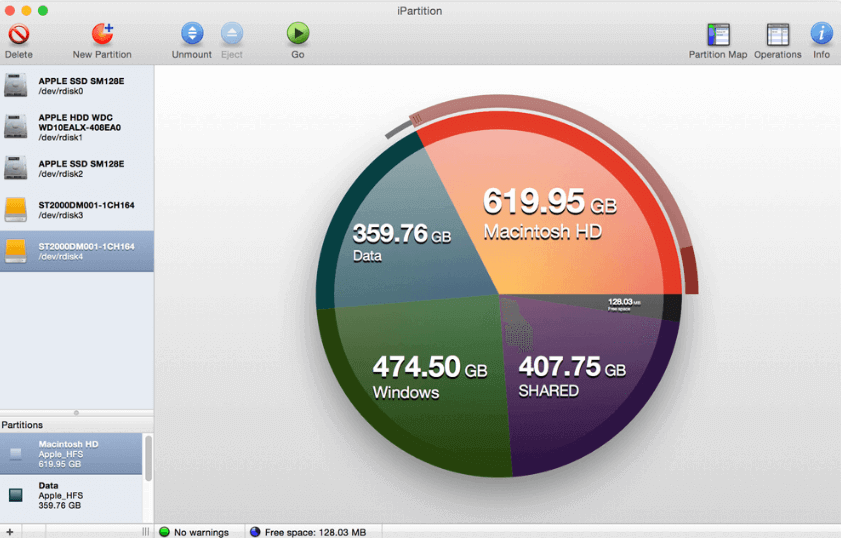

- #Partition tool mac how to
- #Partition tool mac for mac
- #Partition tool mac free
How to Recover Data From a Deleted Partition on Mac
Follow the on-screen instructions depending on what edits you want to make. Click the Partition icon on the menu at the top of the screen. Choose the needed partition from the left side menu.  Head to Launchpad and open Disk Utility. To perform any of these actions, you should do the following: Everything that needs to be done with the partitions can be completed through this app: adding new partitions, formatting them, repartitioning, deleting partitions, etc. You can edit the disk partition on your Mac via Disk Utility. Once you format your partition, all of the data located there will get erased. Important: If you decide to change the partition scheme type, make sure you have a backup available. FAT is used for volumes over 32 GB and exFAT for the ones that are 32 GB or less in size. MS-DOS (FAT) and exFAT - These file systems are a great option if you plan on using the partitioned hard drive to share files across macOS and Windows platforms. But otherwise, it is recommended to use APFS since it comes with many essential features. It’s a good option for older Macs or for cross-compatibility (when you have an old Mac that doesn’t support APFS and a new Mac). HFS+ (Mac OS Extended) - This file system is used with older macOS versions ( macOS 10.12 or earlier). It is an excellent option for Macs that run newer macOS versions and for SSDs. It offers higher speeds, stronger encryption, and better data handling compared to HFS+. APFS (Apple File System) - This is the default file system for Macs that run macOS 10.13 High Sierra or later. There are three types of Mac partitions (also known as partition schemes): When you partition your hard drive, you get the option of choosing the needed format, which is why it is important to be aware of the partition types. Many choose to partition their Macs specifically to be able to use two different operating systems on their device at the same time. By doing it, you’ll also be splitting the HDD capacity between those systems (but you can adjust the partition size when creating it). Partitioning basically means splitting an internal or external hard drive into separate storage systems.
Head to Launchpad and open Disk Utility. To perform any of these actions, you should do the following: Everything that needs to be done with the partitions can be completed through this app: adding new partitions, formatting them, repartitioning, deleting partitions, etc. You can edit the disk partition on your Mac via Disk Utility. Once you format your partition, all of the data located there will get erased. Important: If you decide to change the partition scheme type, make sure you have a backup available. FAT is used for volumes over 32 GB and exFAT for the ones that are 32 GB or less in size. MS-DOS (FAT) and exFAT - These file systems are a great option if you plan on using the partitioned hard drive to share files across macOS and Windows platforms. But otherwise, it is recommended to use APFS since it comes with many essential features. It’s a good option for older Macs or for cross-compatibility (when you have an old Mac that doesn’t support APFS and a new Mac). HFS+ (Mac OS Extended) - This file system is used with older macOS versions ( macOS 10.12 or earlier). It is an excellent option for Macs that run newer macOS versions and for SSDs. It offers higher speeds, stronger encryption, and better data handling compared to HFS+. APFS (Apple File System) - This is the default file system for Macs that run macOS 10.13 High Sierra or later. There are three types of Mac partitions (also known as partition schemes): When you partition your hard drive, you get the option of choosing the needed format, which is why it is important to be aware of the partition types. Many choose to partition their Macs specifically to be able to use two different operating systems on their device at the same time. By doing it, you’ll also be splitting the HDD capacity between those systems (but you can adjust the partition size when creating it). Partitioning basically means splitting an internal or external hard drive into separate storage systems. 
Option #2: Format the Hard Drive Partition.Option #1: Repair the Partition Map Using Disk Utility.How to Recover the Entire Partition on a Mac.How to Recover Data From a Deleted Partition on Mac.
Paragon Hard Disk Manager for Mac Compatibility: OS X 10. The list contains the top 9 partition management tools that are highly compatible with the latest and older macOS versions. Here Are The 9 Best Partition Managers for Mac 2022 When the need arises to restore a lost partition.
Can’t resize the boot camp partition to free up your Mac’s disk space.There are partition issues where Disk Utility might not be helpful.You might not be able to manage partitions for separate operating systems such as Mac, Linux, and Windows.Disk utility offers limited functionality when managing different file systems such as APFS and HFS+.

When Mac already has an inbuilt “Disk Utility” for the same, why would you have another Mac partitioning tool or a separate hard disk manager? True, you have Disk Utility! And it is indeed a great tool, however, you will need to opt for a separate Mac partition tool – But, Then What’s The Need For A Third-party macOS Partition Manager?








 0 kommentar(er)
0 kommentar(er)
